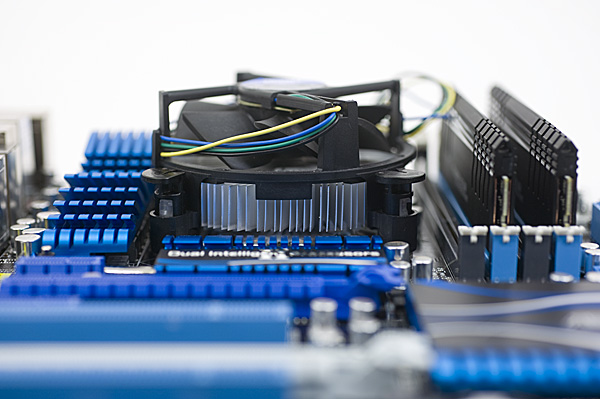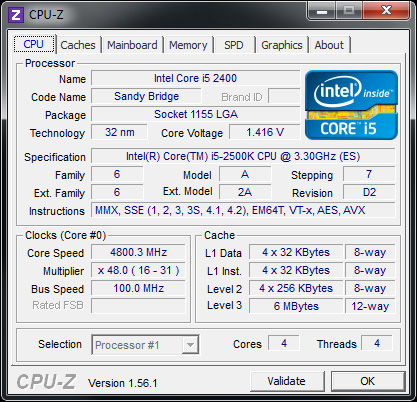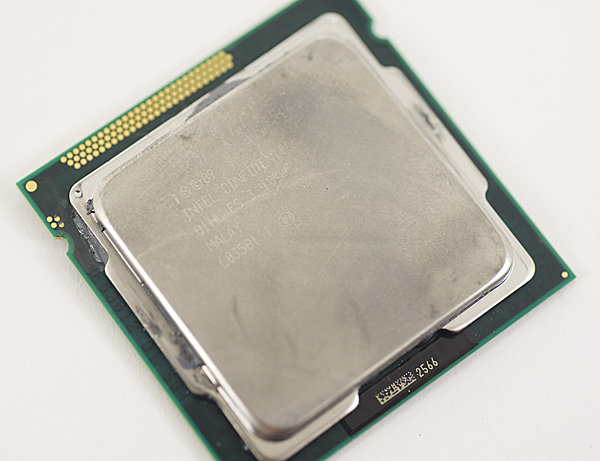The Sandy Bridge Review: Intel Core i7-2600K, i5-2500K and Core i3-2100 Tested
by Anand Lal Shimpi on January 3, 2011 12:01 AM ESTOverclocking, the K-Series and What You’ll Want to Buy
If you haven’t noticed, the computing world is becoming more integrated. We review highly integrated SoCs in our smartphone coverage, and even on the desktop we’re seeing movement towards beefy SoCs. AMD pioneered the integrated memory controller on desktop PCs, Intel followed suit and with Lynnfield brought a PCIe controller on-die as well. Sandy Bridge takes the next logical step and brings a GPU on-die, a move matched by AMD with Brazos and Llano this year.
In the spirit of integration, Intel made one more change this round: the 6-series chipsets integrate the clock generator. What once was a component on the motherboard, the PLL is now on the 6-series chipset die. The integrated PLL feeds a source clock to everything from the SATA and PCIe controllers to the SNB CPU itself. With many components driven off of this one clock, Intel has locked it down pretty tight.
With Nehalem and Westmere, to overclock you simply adjusted the BCLK from 133MHz to whatever speed you wanted and sometimes toyed with multipliers to arrive at a happy end result. With Sandy Bridge, the BCLK generated on the 6-series PCH is at 100MHz by default and honestly won’t go much higher than that.
While I’ve heard reports of getting as high as 115MHz, I’d view 103—105MHz as the upper limit for what you’re going to get out of BCLK overclocking. In other words: next to nothing. A 105MHz BCLK overclock on a Core i7-2600 will take you from a stock speed of 3.4GHz to a whopping 3.57GHz. The form of overclocking we’ve been using for the past decade is effectively dead on Sandy Bridge.
Years ago, before the Pentium II, we didn’t rely on BCLK (or back then it was just FSB or bus overclocking) to overclock. Back then, if we wanted a faster CPU we’d just increase the clock multiplier. Intel has dabbled in offering multiplier unlocked parts for overclockers, we saw this last year with the Core i7 875K for example. With Sandy Bridge, those unlocked parts are going to be a lot more important to overclockers.
It works like this. If you have a part that does not support Turbo (e.g. Core i3-2100 series), then your CPU is completely clock locked. You can’t overclock it at all, have fun at your stock frequency. This is good news for AMD as it makes AMD even more attractive at those price points.
If you have a part that does support turbo (e.g. Core i5-2400), then you have what’s called a “limited unlocked” core—in other words you can overclock a little bit. These parts are limited to an overclock of 4 processor bins above and beyond the highest turbo frequency. Confused yet? This chart may help:
In this case we’re looking at a Core i5-2500, which runs at 3.3GHz by default. When a single core is active, the chip can turbo up to 3.7GHz. If you want, you can change that turbo state to go as high as 4.1GHz (if your CPU and cooling can keep up).
Overclocking these limited unlocked chips relies entirely on turbo however. In the case above, the fastest your chip will run is 4.1GHz but with only one core active. If you have four cores active the fastest your chip can run is 3.8GHz. While Intel didn’t sample any limited unlocked parts, from what I’ve heard you shouldn’t have any problems hitting these multiplier limits.
There’s a third class of part: a fully unlocked K-series chip. At launch there are only two of these processors: the Core i5-2500K and the Core i7-2600K. Anything with a K at the end of it means you get all multipliers from 16x all the way up to 57x at your disposal. It’s effectively fully unlocked.

These chips overclock very well. Both my Core i5-2500K and Core i7-2600K hit ~4.4GHz, fully stable, using the stock low-profile cooler.

This is all you need for 4.4GHz
With a bit more effort and a better cooler, you can get anywhere in the 4.6-5.0GHz range:

It's a bit too early to tell how solid these near-5GHz overclocks will be, but I'm confident in the sub-4.5GHz overclocks we were able to sustain.
You do pay a price premium for these K-series SKUs. The 2500K will cost you another $11 over a stock 2500 and the 2600K costs an extra $23. In the case of the 2500K, that’s a small enough premium that it’s honestly worth it. You pay $11 extra for a chip that is very conservatively clocked and just begging for you to overclock it. Even the 2600K’s premium isn’t bad at all.
| Model Number | Standard SKU | K-Series SKU | Price Premium |
| Intel Core i7-2600 | $294 | $317 | +$23 |
| Intel Core i5-2500 | $205 | $216 | +$11 |
As an added bonus, both K-series SKUs get Intel’s HD Graphics 3000, while the non-K series SKUs are left with the lower HD Graphics 2000 GPU.
Compared to Lynnfield, you’re paying $11 more than a Core i5-760 and you’re getting around 10-45% more performance, even before you overclock. In a perfect world I’d want all chips to ship unlocked; in a less perfect world I’d want there to be no price premium for the K-series SKUs, but at the end of the day what Intel is asking for here isn’t absurd. On the bright side, it does vastly simplify Intel’s product stack when recommending to enthusiasts: just buy anything with a K at the end of it.
Since we’re relying on multiplier adjustment alone for overclocking, your motherboard and memory actually matter less for overclocking with Sandy Bridge than they did with P55. On both P67 and H67, memory ratios are fully unlocked so you can independently set memory speed and CPU speed. Even the GPU ratios are fully unlocked on all platforms and fully independent from everything else.












283 Comments
View All Comments
Mark_12 - Saturday, June 26, 2021 - link
There are a lot of cheaters nowadays concerning gambling. It all depends on the purpose of pokies slots games. For me it is a way to relax and enjoy the process of playing and winning at https://awfulannouncing.com/gambling/where-you-can... . I love the feeling of winning and the thrill of a large selection of slots. By the way you know that there are a lot of legitimate sites now that provide a large selection. Since every player likes to play in his own wayJumpingJack - Saturday, February 7, 2015 - link
Didn't turn out well did it?BSMonitor - Tuesday, January 4, 2011 - link
You'd spend $80 on a 6-core MB ?? LOLIf you buy a 6-core Phenom, likely you'll be in th 140-180 range for a decent MB..
Funny how the cheapers rationalize their cheapness.
zipzoomflyhigh - Tuesday, January 4, 2011 - link
That's not true at all. Most $40-50 AM3 mobo's support X6. If you don't game or overclock, you don't need extra pci-e lanes and extra cooling. Especially for a workstation.Oxford Guy - Monday, January 3, 2011 - link
Yeah, I'm stoked about the new low-level DRM.This is sure to run it fast.
talevski - Thursday, January 6, 2011 - link
i think that amd 880g mainbord with cpu araound 90 dolars plus some 55xx series gpu can do better in terms of encoding decoding video playback games etc. and all that without alot of money spend on inetl new socekets wich you have to trow away when they make the next cpu.So please corect me if i am wrongto anandtech&co
pshen7 - Tuesday, February 22, 2011 - link
The charts and the numbers say it all. This is definitely worth an upgrade for me!Peter Shen, founder Koowie.com
Shifu_V - Saturday, April 16, 2011 - link
Hi everyone, i dicided to build a PC but made an 1 error getting the i7 2600 if anyone is interested in buying one please let me, it's brand new sealed in it original contents.and i dont mind trading it in for a i7 2600k.
and i will match the price maybe even better
My email:vinay_chauhan20042000@yahoo.co.uk
Skott - Monday, January 3, 2011 - link
I'm wondering how supply will be on release day? Often we see new components with low supply and online stores start price gouging from day one. New Egg is particularly known for such. Lets hope supply is very good off the bat. That 2600K looks really appealing to me.evilspoons - Monday, January 3, 2011 - link
One of the local computer stores had Sandy Bridge parts up for sale last week, but they're all gone now save for a few Asus P8P67 standard, pro, and deluxe boards.I wasn't able to see what kind of money they were asking.
This review has convinced me that once the 2600K shows up again it's all I'll need. I was going to wait for socket 2011 but damn, the 2600 is already more than twice as fast in everything than my poor ol' Q6600.